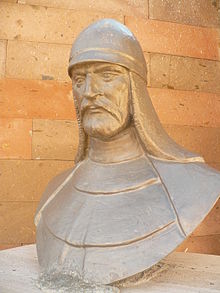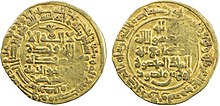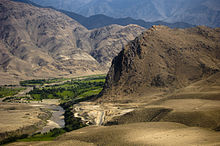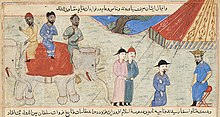Ghaznavid campaigns in India
The Ghaznavid campaigns in India refer to a series of military expeditions lasting 54 years (973–1027)[original research?]They went into the Indian subcontinent, led primarily by Sultan Mahmud of Ghazni (r. 998–1030), leaving a profound impact on the region's history and culture.[2][page needed] Beginning in the late 10th century, these incursions marked a significant chapter in the history of South Asia, with Ghaznavid forces penetrating deep into the Indian subcontinent, including the Punjab region and northern India.The primary objectives of these campaigns included the acquisition of wealth, the propagation of Islam, and the establishment of Ghaznavid rule in the region.The Ghaznavid campaigns in India serve as a crucial historical backdrop to the later Islamic empires that would shape the subcontinent's destiny.Sabuktigin's forces defeated the combined armies of Lawik and the Hindu Shahis, resulting in the death and capture of many of their soldiers.[3][38] Sabuktigin ascended to the throne of Ghazni in 977, and embarked on a series of wars with Indian kingdoms in the late 10th century.These conflicts with Indian kingdoms solidified the Ghaznavids as a formidable power in India and laid the groundwork for the more renowned invasions led by Mahmud of Ghazni in the subsequent century.Initially, Sabuktigin faced opposition from Toghan and subsequently marched against him, leading to the capture of Kandahar and its surrounding areas.As a result, Jayapala, the Hindu Shahi ruler, was compelled to pay a substantial tribute to Sabuktigin and cede both territories and a few fortsTo avenge the defeat at Laghman, Jayapala orchestrated the formation of a confederacy comprising Hindu chiefs from the Tomara dynasty, Gurjara-Pratihara dynasty, Chahamanas, and Chandelas.Seeing the disproportion of the manpower, Sabuktigin divided his troops into squadrons of 500 men each, and directed them to attack the enemy on one particular point.He had increased Alptigin's domains to cover the area south of the Hindu Kush in Afghanistan and east to the Indus River in what is today Pakistan.While Mahmud's conquests were driven by a desire for wealth and power, they also led to the spread of Persian culture and the introduction of Islam in the region.His expeditions marked the beginning of a series of foreign invasions into India, ultimately shaping the course of its history for centuries to come.[citation needed] The battle raged on for three days, resulting in heavy casualties for Biji Rai's forces.[42] Mahmud continued his march towards Multan and, upon reaching the city, Fateh Daud surrendered it to him and agreed to pay an annual tribute.On his way back to Ghazni, Mahmud appointed a Hindu convert named Nawassa Shah (also known as Sukhapala) to oversee the Indian territories.Mahmud responded by marching towards Multan, where he not only quelled the rebellion but also inflicted heavy casualties among heretics and took Daud as a prisoner.The terms of the agreement stipulated that he would annually pay a substantial tribute equivalent to the profits generated from his territories and the looting of his cities.Tragically, many of the defenders, along with their wives and children, chose to immolate themselves in the fire, while others leaped from the fort onto the battlefield, preferring death over dishonor.I regard his bridle as much stronger than yours, for he never con- tents himself with one blow of the sword nor does his army satisfy itself with one hill out of a whole range.Trilochanapala's army was defeated by the Ghaznavid forces, compelling him to retreat from the battlefield, resulting in the loss of many of his soldiers.The Sultan laid siege to the fort of Kalinjar, and after a fierce conflict, both parties opted for a peace treaty.








Muslim conquests in the Indian subcontinentAfghanistanPakistanNorthern IndiaGhaznavid empireQarmatiansGurjara-Pratihara dynastyChaulukya dynastyRashtrakutas of KannaujGahadavala DynastyKachchhapaghata dynastyLawik dynastyHindu ShahisRajput confederacyChandelasLodi dynasty of MultanHabbari dynastyTomara dynastyLohara dynastySabuktiginMahmud of GhazniMas'ud III of GhazniKhusrau ShahJayapalaAbu Ali LawikFateh DaudBhima IVidyadharaIndian subcontinentSultan Mahmud of GhazniPunjabLaghmanPeshawarHindu ShahiIslamic empiresCharkhFirst Battle of LaghmanSecond Battle of LaghmanBattle of Peshawar (1001)GandharaIndus RiverAnandapalaKashmirMultanBattle of ChachThanesarSiege of Lohkot (1015)SangramarajacasualtiesWinter stormNandanaTrilochanapalaKashmir KingdomBulandshahrMahabanMathuraGhaznavid invasion of KannaujMunjhawanBrahminsSirsawaGwaliorKalinjarSack of SomnathAhmad NiyaltiginKalachuris of TripuriKangra valleyKalachurisGhaznavidsMawdud of GhazniParamara DynastyRaja BhojaLakshmikarnaChahamana dynastyChamundarajaRashtrakutasLakshmadevaKirtivarmanKalinjaraChahamanas of ShakambhariPrithviraja IAjayaraja IIChauhan DynastyAlptiginGhazniAbu IshaqBilgetiginBoritiginChahamanasTurkictemplesSomnath TemplePersian cultureimmolated himselfSalt RangesRajputLohara kingSiege of LohkotSangramrajaGurjara-PratiharaKannaujYamunaBrahminChandelaVidhyadaraGwalior fortKachchhapaghata